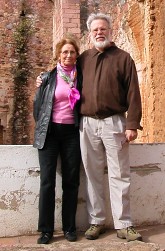This is Mozart season. The other evening we went to what we thought was another free concert at the Teatro de la Republica, and it turned out to cost $110 MN, not US, each. We reluctantly forked over $220 and went in. It turns out that rather than a little chamber orchestra as we had thought, it was the Querétaro symphony orchestra playing Mozart's Jupiter and his piano concierto #21, and some forgettable Shostakovich. Wow! It was worth a lot more than $220. At intermission, we bought tickets for their Requiem concert in a couple of weeks. We even bought tickets for Maria and Bob (tomorrow is Maria's birthday at Chucho El Roto restaurant where she teaches English to the waiters for free dinners.) When you feel depressed or need a pick-me-up, just walk around Querétaro and there is bound to be something going on to raise your spirits, even if it is COLD. Last night we went to San Antonio (the church, not the city) for a youth orchestra concert of chamber music. Pretty good, especially the encore, Albinoni's concierto for cello/guitar that was so popular years ago.
Imelda just arrived for her Thursday clean-up. She has the cold that C and I had for 10+ days, sore throat, slight fever, cough, phlegm. And she says that it is abnormally COLD for this time of year, and that this kind of weather usually lasts for two weeks in January. (Yeah, right.) Must be W's fault, i.e., "it'll be a cold day in hell when we lose both the house and the senate."
Lee, the ex-Peace Corps volunteer, Francis the guy from Canada and I have been making excursions to draw and paint. It is not exactly like Monet and friends heading to Normandy to paint the sea, but you gotta start somewhere. However, this week it is too COLD to go out. Lee has had some health problems, but it looks like he will be going to Guatemala, where his wife is living, with the Peace Corps' Crisis Corps for Returned Peace Corps Volunteers. It is reportedly not much warmer in Guatemala.
This afternoon, we are having an early Thanksgiving meal (turkey tacos, I think; maybe enchiladas) with Pierre, Sophie and Antoine at 3 PM. This evening, we are going to a book signing and lecture that Edgardo is giving on his new book on the history of the theater in Querétaro, all 450 years of it. We may go to his house for a party afterwards, which leads me into my picture below, as I hope there will be an art historian at his party who can help me out.
I mentioned previously that there is a fresco under the paint on the walls of the entranceway. Here is a picture of some of what I have uncovered so far.

You can see a horizontal band of a reddish color along with a vertical band near the door on the right. This is a fresco in the stucco which has been covered by many layers of paint, most recently by blue and green in the late 20th c. Just above the horizontal band are what appear to be roots running horizontally in the same reddish brown. These lead to something on the left, but exactly what is still unknown. I am wondering if the roots lead to a vine or a tree or something. There are also two areas of very faint color midway along the roots, two little spots of paint, one blue and one yellow. Are these fruit, some kind of decoration, or are they unrelated to what seem to be roots? I need someone with some knowledge of how houses were painted 150-200 years ago and what I should expect before I start removing much more of the overlying paint, essentially destroying what might be contained therein. Even vertical archaeology is a destructive process.
This past month, the cactus have been growing by leaps and bounds. I thought they were all dead a couple of months ago, but now they are sprouting new leaves and branches. The tall one in the foreground (below) did not have the shiny new branches/leaves before, and they seem to grow larger every day. The shorter one in the foreground did not have any of the ball-like appendages that are so evident now. And the ones in the pot in the background have new little branches coming up from the bottom. We have always had trouble with cactus and never thought you could actually keep them alive, much less watch them grow. It is fascinating, especially if you have a magnifying glass to see the little thorns and appendages.





